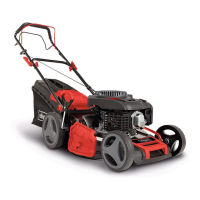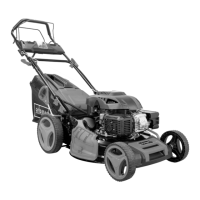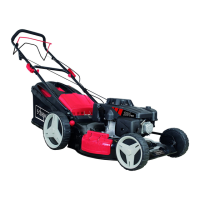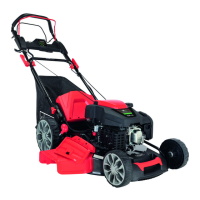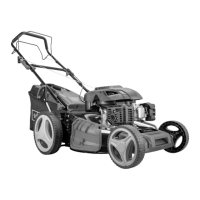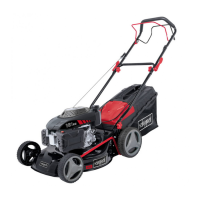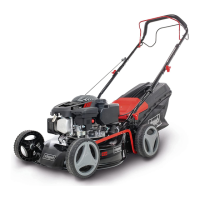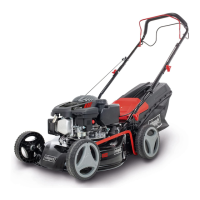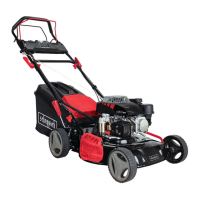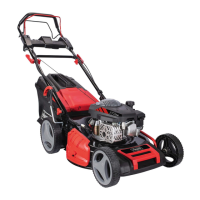• If fuel overflows, no attempts should be made to
start the engine. Instead, the product must be re-
moved from the area contaminated with fuel. Do not
try to start the engine until the fuel vapours have
evaporated.
• For safety reasons, the fuel tanks and other fuel
caps must be replaced if damaged.
• Never store fuel near a source of sparks. Always
use a tested canister. Keep fuel away from children.
• Replace defective silencers.
• Prior to use. always perform a visual inspection to
check whether the blade and fastening bolts are
worn out or damaged. To prevent an imbalance,
worn out or damaged blades and bolts may only be
replaced in sets.
Handling:
• Make sure that all nuts, bolts and screws are se-
curely tightened so that the product is kept in a safe
working condition.
• Never store the product with fuel in the tank inside a
building in which fuel vapours may come into con-
tact with naked flames or sparks.
• Allow the engine to cool down before parking the
product in enclosed spaces.
• In order to avoid fire hazards, keep the engine, ex-
haust pipe and the area around the fuel tank free of
grass, leaves and leaking grease (oil).
• Regularly check the catch basket for signs of wear
and loss of functionality.
• For safety reasons, replace worn or damaged parts.
• If the fuel tank has to be drained, you must do this
outdoors.
• Do not run the combustion engine in closed rooms
in which hazardous carbon monoxide can collect.
• Only mow in daylight or with good artificial lighting.
• Avoid using the product on wet grass as far as pos-
sible.
• Do not use the product in a thunderstorm - Danger
of lightning strike!
• Always maintain good footing on inclines.
• Only guide the product at walking pace.
• The following applies to wheeled products: Always
mow across hills i.e. never straight up or straight
down. Take particular care when changing direction
on a slope.
• Do not mow on excessively steep slopes and near-
by rubbish tips, ditches and dykes. Take particular
care when reversing the product or pulling it to-
wards you.
• Stop the blade when the lawnmower has to be tilt-
ed, when transporting over areas other than grass
and when moving the lawnmower to and from the
area to be mowed.
CAUTION
The lawnmower must not be used without either the
full grass catcher or the self-closing separating guard
for the ejection opening in place.
• Never use the lawnmower if the blade or safety
grilles are damaged, or without the attached guards,
e.g. deflectors and/or grass catching devices.
• Do not adjust and overclock the engine speed set-
tings.
• Release the engine brake and disengage all cutting
tools and drives before starting the engine.
• Start the engine with care, in accordance with the
manufacturers instructions. Ensure that your feet
are far enough away from the blade.
• Do not tip the lawnmower when you start the engine
unless the lawnmower must be raised off of the
ground a little in order to start it. In this case, only tilt
as far as absolutely required and only lift the side
away from the operator.
• Do not start the engine if you are standing in front of
the ejector chute.
• Never out hands and feet on or under rotating parts.
Always keep clear of the ejection opening.
• Never lift or carry a lawnmower while the engine is
running.
• Stop the engine and make sure that all moving
parts have come to a standstill and that the ignition
key, if present, is removed:
– Before you dislodge any blockages or clogs in
the ejector chute.
– Before checking or cleaning the product, or per-
forming work on it.
– If it came into contact with a foreign object. In-
spect the product for damage and perform the
required repairs before starting again and work-
ing with the product. If the product begins to ex-
perience exceptionally strong vibrations, switch
it off immediately and check it.
– Any time you leave the product.
– Before you refuel.
• When the engine runs out, close the throttle valve. If
the engine has a petrol shut-off valve, close it after
use.
• Operating the product at excessive speed can in-
crease the risk of accidents.
• Be careful when adjusting the product and avoid
trapping fingers between the moving blade and rigid
parts of the device.
• Be particularly careful when mowing on yielding
ground, nearby rubbish tips, ditches and dykes.
• Avoid mowing in places where the wheels have
trouble gripping or mowing is unsafe in any other
way.
• Watch out for traffic near a road.
32 | GB www.scheppach.com
